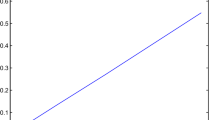We propose a mathematical model of motion of an elastic body along a hard surface in the absence of friction forces. The formulations of the problem in the form of a variational inequality and in the form of the extremum variational problem are obtained. For the discretization of the extremum variational problem, we use the finite-element method. As an example, we consider the motion of a body with rectangular cross section under the conditions of plane deformation. We investigate strains and stresses formed in the case of motion along the surfaces in the horizontal and vertical directions.
Similar content being viewed by others
References
I. V. Beiko, B. N. Bublik, and P. N. Zin’ko, Methods and Algorithms for the Solution of the Problems of Optimization [in Russian], Vyshcha Shkola, Kiev (1983).
I. Glavacek, J. Gaslinger, I. Nechas, and J. Lovicek, Solution of Variational Inequalities in Mechanics [Russian translation], Mir, Moscow (1986).
R. Glowinski, J.-L. Lions, and R. Trémolières, Numerical Analysis of Variational Inequalities, North-Holland, Amsterdam–New York–Oxford (1981).
A. S. Kravchuk, Variational and Quasivariational Inequalities in Mechanics [in Russian], Moscow State Academy of Instrument-Making and Automatics, Moscow (1997).
A. S. Kravchuk, “The variational method in contact problems. The present state of the problem and trends in its development,” Prikl. Mat. Mekh., 73, No. 3, 492–502 (2009); English translation: J. Appl. Math. Mech., 73, No. 3, 351–357 (2009).
A. S. Kravchuk, “Development of a solution method for frictional contact problems with complex loading,” Izv. Ross. Akad. Nauk. Mekh. Tverd. Tela, No. 3, 22–32 (2007); English translation: Mech. Solids, 42, No. 3, 346–355 (2007).
V. I. Kuz’menko and A. I. Mikhal’chuk, “Investigation of the stressed state of the body in contact problems of adhesive motion,” Visn. Dnipropetrovs’k. Univ., Mekhanika, Issue 8, Vol. 2, 129–136 (2004).
G. I. L’vov, “Variational statement of the contact problem for linearly elastic and physically nonlinear shallow shells,” Prikl. Mat. Mekh., 46, No. 5, 841–846 (1982).
R. M. Martynyak, “Thermal stress state of a bimaterial with closed interfacial crack having rough surfaces,” Mat. Met. Fiz.-Mekh. Polya, 53, No. 1, 71–79 (2010); English translation: J. Math. Sci., 176, No. 4, 578–589 (2011).
R. M. Martynyak, B. S. Slobodyan, V. M. Zelenyak, “Pressure of an elastic half space on a rigid base with rectangular hole in the case of a liquid bridge between them,” Mat. Met. Fiz.-Mekh. Polya, 51, No. 1, 150–156 (2008); English translation: J. Math. Sci., 160, No. 4, 470–477 (2009).
A. I. Mikhal’chuk and V. I. Kuz’menko, “Computer analysis of the processes of adhesive motion,” Probl. Obchysl. Mekh, Mitsn. Konstruk., Issue 17, 202–210 (2011).
K. Rektoris, Variational Methods in Mathematics, Science, and Engineering, Reidel, Dordrecht (1977).
L. J. Segerling, Applied Finite Element Analysis, John Wiley & Sons, New York (1976).
S. A. Chernopazov and V. V. Shyshlyaev, “Variational statement of the contact problem in the theory of elasticity with regard for friction on the contact surface,” Vestn. Perm. Gosud. Tekhn. Univ. Prikl. Mat. Mekh., No. 1, 83–90 (2003).
S. Aleynikov, Spatial Contact Problems in Geotechnics. Boundary-Element Method, Springer, Berlin–Heidelberg (2010).
N. Kikuchi and K. Skalski, “An elasto-plastic rigid punch problem using variational inequalities,” Arch. Mech. Stosow, 33, No. 6, 865–877 (1981).
A. Kravchuk and P. Neittaanmäki, Variational and Quasi-Variational Inequalities in Mechanics, Springer, Dordrecht (2007).
T. A. Laursen, Computational Contact and Impact Mechanics: Fundamentals of Modeling Interfacial Phenomena in Nonlinear Finite Element Analysis, Springer, Heidelberg (2002).
J.-L. Lions and G. Stampacchia, “Variational inequalities,” Comm. Pure Appl. Math., 20, No. 3, 493–519 (1967).
M. Sofonea and A. Matei, “History-dependent quasi-variational inequalities arising in contact mechanics,” Eur. J. Appl. Math., 22, No. 5, 471–491 (2011).
A. Touzaline, “Study of a viscoelastic frictional contact problem with adhesion,” Comment. Math. Univ. Carolin., 52, No. 2, 257–272 (2011).
P. Wriggers, Computational Contact Mechanics, Springer, Berlin–Heidelberg (2006).
Author information
Authors and Affiliations
Additional information
Translated from Matematychni Metody ta Fizyko-Mekhanichni Polya, Vol. 56, No. 1, pp. 84–93, January–March, 2013.
Rights and permissions
About this article
Cite this article
Kuz’menko, V.І., Mykhal’chuk, H.I. Contact Problems of Motion of Elastic Bodies Along Hard Surfaces. J Math Sci 201, 99–110 (2014). https://doi.org/10.1007/s10958-014-1976-y
Received:
Published:
Issue Date:
DOI: https://doi.org/10.1007/s10958-014-1976-y



